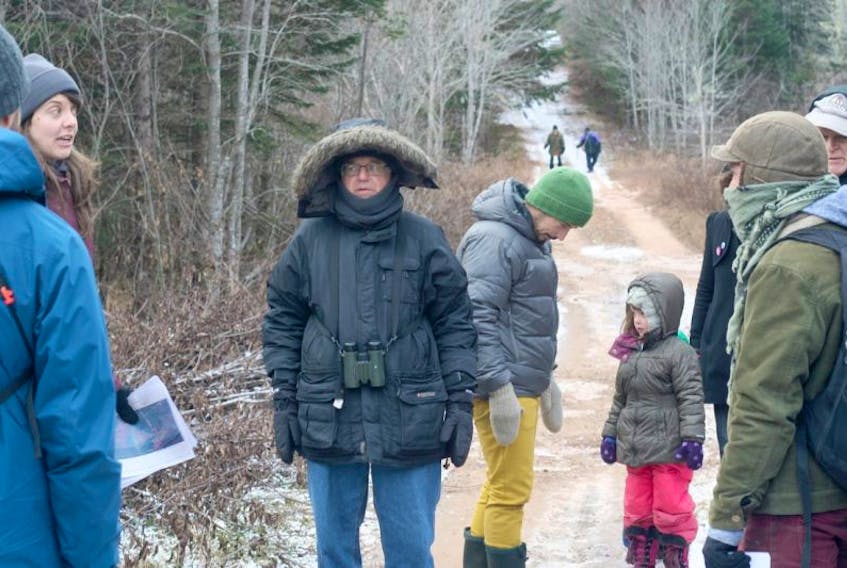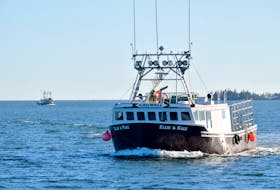Volunteers with the Ecology Action Centre organized a bio blitz, or environmental survey, of one section of the pipeline route in December. The group of about two dozen concerned citizens, naturalists and biologists were taking note of what plants and animals they found in the pipeline route, but also natural features like wetlands.
The intent was to double-check information contained in the environmental assessment of the pipeline project.
“The consultants who do the surveys for the assessment are a third party trusted to do the work, but no one from government comes to physically check the work,” says Ken Summers, an environmental activist from Minasville, Hants County.
He became interested in the Alton Gas pipeline when he learned the proponents wanted to put it through a proposed wilderness area.
“We don't have a lot of wilderness in central Nova Scotia so I was curious to see this place. I’ve been down a few times and just walked through the area. The pipeline route goes through the most attractive part of that wilderness, that corridor along the river has huge hemlocks on it. It is quite peaceful in there.”
Summers says the wetland is about 10 metres by 50 metres and is just north of the Stewiacke River where the pipeline route crosses the river.
“Wetlands are a big deal,” says Summers. “Mostly because the amount of wetlands is declining due to various human activities. They are disappearing and that’s why there is no such thing as an insignificant wetland. Which is why every watercourse and wetland is supposed to be identified and described in the environmental assessment.”
Summers says the environmental assessment does identify a similar wetland by the shore about 200 metres to the east but does not show the wetland the volunteers found on Dec. 10 in the middle of the pipeline route.
Chris Miller, of the Canadian Parks and Wilderness Society (CPAWS), says the route selection was already contentious because the pipeline would create a 10-metre swath of cleared forest through the middle of the proposed Stewiacke River Wilderness Area.
“A pipeline is totally incompatible with a wilderness area,” says Miller. “Damage to these ecologically important areas caused by a pipeline could be extensive. This area holds important stands of old eastern hemlock and red oak along the river. This area is ecologically significant, as it provides habitat for wood turtle, and Atlantic salmon spawn in the river.”
The Nova Scotia government first acquired the land in question in 2010 from Northern Pulp with the intention of protecting it. The Colin Stewart Forest Forum first identified the area as a candidate protection area in 2009.
A spokesperson with Nova Scotia Environment said by email that the Environmental Assessment (EA) approval has specific conditions that relate to wetlands.
“The approval holder has to provide GPS co-ordinates and shape files for all of the wetlands in the pipeline corridor and has to obtain further approval from NS Environment for all wetland alterations,” reads the email.
Volunteers with the Ecology Action Centre organized a bio blitz, or environmental survey, of one section of the pipeline route in December. The group of about two dozen concerned citizens, naturalists and biologists were taking note of what plants and animals they found in the pipeline route, but also natural features like wetlands.
The intent was to double-check information contained in the environmental assessment of the pipeline project.
“The consultants who do the surveys for the assessment are a third party trusted to do the work, but no one from government comes to physically check the work,” says Ken Summers, an environmental activist from Minasville, Hants County.
He became interested in the Alton Gas pipeline when he learned the proponents wanted to put it through a proposed wilderness area.
“We don't have a lot of wilderness in central Nova Scotia so I was curious to see this place. I’ve been down a few times and just walked through the area. The pipeline route goes through the most attractive part of that wilderness, that corridor along the river has huge hemlocks on it. It is quite peaceful in there.”
Summers says the wetland is about 10 metres by 50 metres and is just north of the Stewiacke River where the pipeline route crosses the river.
“Wetlands are a big deal,” says Summers. “Mostly because the amount of wetlands is declining due to various human activities. They are disappearing and that’s why there is no such thing as an insignificant wetland. Which is why every watercourse and wetland is supposed to be identified and described in the environmental assessment.”
Summers says the environmental assessment does identify a similar wetland by the shore about 200 metres to the east but does not show the wetland the volunteers found on Dec. 10 in the middle of the pipeline route.
Chris Miller, of the Canadian Parks and Wilderness Society (CPAWS), says the route selection was already contentious because the pipeline would create a 10-metre swath of cleared forest through the middle of the proposed Stewiacke River Wilderness Area.
“A pipeline is totally incompatible with a wilderness area,” says Miller. “Damage to these ecologically important areas caused by a pipeline could be extensive. This area holds important stands of old eastern hemlock and red oak along the river. This area is ecologically significant, as it provides habitat for wood turtle, and Atlantic salmon spawn in the river.”
The Nova Scotia government first acquired the land in question in 2010 from Northern Pulp with the intention of protecting it. The Colin Stewart Forest Forum first identified the area as a candidate protection area in 2009.
A spokesperson with Nova Scotia Environment said by email that the Environmental Assessment (EA) approval has specific conditions that relate to wetlands.
“The approval holder has to provide GPS co-ordinates and shape files for all of the wetlands in the pipeline corridor and has to obtain further approval from NS Environment for all wetland alterations,” reads the email.









